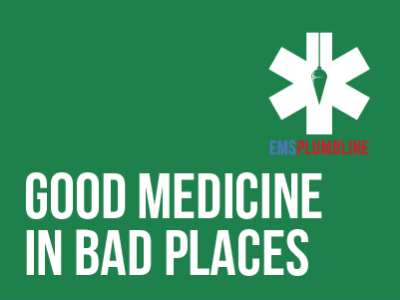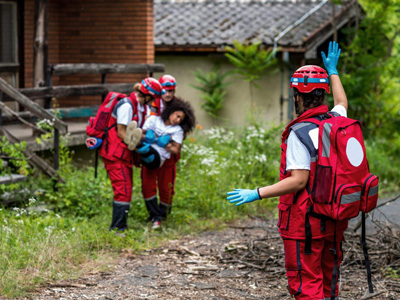 |
Canva |
0.75 |
This course covers how to use Canva and what it can be used for. |
 |
Capacitación sobre seguridad en andamios y escaleras de mano (Spanish) Scaffold and Ladder Safety Training |
0.50 |
Este curso cubre cómo corregir o eliminar peligros de caídas relacionados con el uso de andamios y escaleras en el lugar de trabajo y comprender los requisitos de la OSHA referentes a seguridad en andamios y escaleras. |
 |
Cardiac Arrest Management of the Firefighter Down |
1.00 |
Career Firefighter Jackeline Vazquez, BSCJ and Medical Director Jeremy Cushman, MD, MS, EMT-P, FACEP, FAEMS discuss the care and management of a cardiac arrest when the victim is a firefighter who is wearing full turnout gear. With the help of the Henrietta Fire District (New York State), this presentation offers many thought-provoking ideas that will assist your department.
Final Exam: Please read each question carefully. You will have two attempts to gain a 70% or higher on this exam. If you are not successful in two attempts, you are welcome to take the course again to gain the certification. |
 |
Career Development: Career Aspirations |
0.75 |
This course will cover how to identify career preferences and seek professional career counseling and how to recognize the types of skills that promote employability, identify your skills, and develop new skills. You will also learn how to explore career options to meet your personal and professional needs, and avoid pitfalls in career exploration. |
 |
Career Development: Career Excellence |
1.25 |
This course will cover how to maintain productivity, develop self‑discipline, and be professional. You will also learn how to establish a professional image and promote yourself within and outside of your organization. You will also learn how to take advantage of skills and talents, learn new skills, and compete with yourself. |
 |
Career Development: Career Strategies |
1.00 |
This course will cover how to define, set, and maintain career goals and avoid career goal-setting pitfalls. You will also learn how to identify the stages of the career development cycle, plan a career strategy, and identify the types of career moves in your organization. |
 |
Career Development: Professional Networking |
1.25 |
This course will cover how to network effectively to advance your career and define your needs, choose a mentor or a coach, and find a sponsor to seek career guidance. You will also learn to communicate effectively and build strong relationships to develop your career network. |
 |
Career Experiences |
2.00 |
In this course, you will hear firsthand accounts of the professional experiences of others, as well as advice for dealing with failure and tips for pursuing happiness in the workplace. |
 |
Career Exploration |
0.75 |
This course covers the process of aligning your skills and interests with a fulfilling career. It is just one of many courses we offer. This course will help you learn about the self-assessment, research, and planning necessary to proactively identify and pursue a career path that is right for you. |
 |
Career Planning and Salary |
1.00 |
In this course you can get career advice if you're looking for a job, planning a change, or looking to gain skills. |
 |
Careers Without College |
1.00 |
There are many different ways to be successful in life. What might be the right career path for some may not be the right choice for you. Finding your niche is important. When selecting the right career path, it’s important to weigh all of your options. In this course, we will explore a wide range of careers available to anyone with various skills and a high school education.
|
 |
Carreras sin universidad (Spanish) Careers Without College |
0.75 |
Hay muchas maneras diferentes de tener éxito en la vida. Lo que podría ser la carrera profesional adecuada para algunos puede no ser la opción adecuada para usted. Encontrar tu nicho es importante. Al seleccionar la carrera profesional adecuada, es importante sopesar todas las opciones. En este curso, exploraremos una amplia gama de carreras disponibles para cualquier persona con diversas habilidades y educación secundaria.
There are many different ways to be successful in life. What might be the right career path for some may not be the right choice for you. Finding your niche is important. When selecting the right career path, it’s important to weigh all of your options. In this course, we will explore a wide range of careers available to anyone with various skills and a high school education.
|
 |
Cartas de Presentación (Spanish) Cover Letters |
0.75 |
A medida que avance en este curso, aprenderá consejos y trucos sobre cómo escribir una carta de presentación. También aprenderá la importancia de una carta de presentación y cómo puede ayudarle a conseguir el trabajo de sus sueños. Haga clic en las tarjetas a continuación para saber cómo cada persona utilizó su carta de presentación para conseguir el trabajo de sus sueños.
As you go through this course, you will learn tips and tricks on how to write a cover letter. You'll also learn the importance of a cover letter and how it can help you get your dream job. Click the cards below to learn how each person used their cover letter to land their dream job. |
 |
Cats |
1.00 |
This course will provide an introduction to cats, including an overview of physical characteristics, habitat, behavior, reproduction and the conservation efforts dedicated to protecting this taxonomic group. |
 |
CERT Firefighter Rehab Operations |
1.00 |
This course is designed to train Community Emergency Response Team (CERT) members to recognize signs of physiological distress in firefighters. It seeks to provide information on how to set up safely and perform non-medical functions of firefighter rehabilitation. You will specifically learn what to do at the incident scene, in the rehab area, and during the rehab process. |
 |
CERT Unit 1: Disaster Preparedness |
1.00 |
The Community Emergency Response Team (CERT) program educates volunteers about disaster preparedness for the hazards that may occur where they live. This course covers the functions of CERT and how CERT fits into your community's emergency preparedness structure. The types of hazards that can affect communities and the hazard's potential to impact people, health, and infrastructure are discussed in this course. In addition, this course also will teach you how to face a potential disaster.
It is just one of many health and safety courses we offer. This course will help you learn the best practices for keeping yourself safe and healthy when on the job. |
 |
CERT Unit 2: Organization |
0.75 |
This course covers the CERT organizational structure, the Incident Command System (ICS), the one-scene size-up process, and how to use CERT standard documents. |
 |
CERT Unit 3 and 4: Disaster Medical Operations |
1.50 |
This course covers life-saving measures CERT volunteers can take when responding to an emergency scene, such as; controlling bleeding and using direct pressure or a tourniquet, maintaining normal body temperature, opening an airway, and positioning a victim correctly. |
 |
CERT Unit 5: Disaster Psychology |
0.75 |
This course covers disaster psychology and how it can be used to improve disaster response. You will also learn about the psychological impact of a disaster on responders and survivors and how this impact can be remedied through psychological first aid. Finally, you will learn about steps to take before, during, and after a disaster as part of a CERT. |
 |
CERT Unit 6: Fire Safety and Utility Controls |
1.00 |
This course covers fire safety and the controls you can use to ensure that safety. You will also learn about the different priorities of fire service that need to be taken into account when responding to fires. These priorities include but are not limited to life safety, incident stabilization, and property conservation. |
 |
CERT Unit 7: Light Search & Rescue Operations |
1.00 |
This course covers how to operate in an effective manner for emergency response and rescue. You will learn how to size up the situation in which the search and rescue team will operate, as well as how to conduct search and rescue operations. Being able to use safe techniques for rescue gives a CERT volunteer a better chance to remove survivors from dangerous situations as well as prevent a CERT volunteer from putting themselves in danger. |
 |
Chainsaw Safety |
0.50 |
This course covers Chainsaw Safety. You will learn the proper ways to start a chainsaw, what it can cut, and how to operate a chainsaw safely. |
 |
Change Management: Adapting to Change |
0.75 |
This course will cover how to identify the truths and misconceptions about change and understand the difference between change and transition. You will learn how to identify the factors that affect the response to change and list the styles of response. You will also learn how to identify the feelings arising during the endings phase and identify the strategies to manage the endings phase. |
 |
Change Management: Change Process |
0.50 |
This course will cover how to identify the steps of a change process, analyze a change situation and identify important aspects of change, and choose an action and identify the restraining and driving forces. You will also learn how to create a sense of urgency, set goals, motivate employees, delegate, and prevent failure as well as how to identify the methods of monitoring the progress of a change. |
 |
Change Management: Coping with Uncertainty |
0.50 |
This course will cover how to understand the emotions and responses experienced during the exploration phase, and identify what people need during the exploration phase. You will also learn how to identify the strategies to manage the exploration phase and identify the steps to manage the uncertainty in the exploration phase. |


























